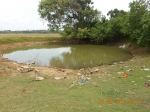Navaly-ur Idikundu Kineru
Abstract Category: Science
Course / Degree: Master of Science
Institution / University: Private, Sri Lanka
Published in: 2015
Idikundu in Tamil means Thunder-bomb. Idi stands for thunder and kundu means bomb, or similar devices that have explosion and hit. The Tamil word kinerru means water-well. Some call it in detail as Idi-vilundha-kinerru; which means: Thunder-fallen-water-well. Vilundha means fallen.
This water-well is in Navaly about 5 km. from Jaffna. As legend goes: it appeared at early twentieth century on a day with heavy rain and thunder storms. People of the region believe it to have no bottom.
Speculations are many. It begins with ominous stories, goes through well-wishing and prosperity for the region with enough water. The theories stretch further into scientific explanations. All have their validity in their own rights.
As for scientific explanations, the first, Stuck by a Thunder with Lightning, fails to stand on firm grounds. Because it should have burnt trees and the explosion is mostly zigzag linear. It cannot form a hole so deep in the ground.
The second, a hit from the space, can have some validity, provided the remnants of crater could be found. It can be meteoritic hit or a hit from an asteroid. The second asteroid theory can hold good only when following points are answered.
1. Asteroid have very high speeds, and the smaller like Chelyabinsk-asteroid, must have some tons in mass. They, when hitting the open ground go deep into the ground, forming tubes resembling water-wells but must have fairly high craters. Chelyabinsk-asteroid, escaped from forming craters because it dashed into a lake.
2. Asteroids produce pressure waves in the air as well as in the ground that could be felt at distances. They have casualties even at distances few hundred metres away from the hit. This appears to be missing. Because people did live in the area at that time. The proof is the house of the famous Tamil poet Navali-ur Somasundhara Pulavar.
The other theory is a hit by a meteorite. Meteorites are, by far smaller, than Asteroids. They bring casualties and damages when hit directly but not from distances. The pressure waves of meteorites are not felt beyond few metres. And they can go into the ground forming water-well like tubes but not deep like the one in Navaly. However many questions remain open to confirm it.
For instance:
1. No crater found. If it had been meteorite it would have left a crater. This would have been discovered without delay by the people living in the area. And the inquisitiveness of the village-people would have sent the message within hours to distances like 50 km. It is absent
2. If it really happened, even today almost after a century, certain minerals like chondrite could be found in the vicinity. Unfortunately, no consequent research and investigations had been done around the water-well.
The third scientific theory is the sinkhole, Karst, doline and cavity theory. Now sinkholes are common threats in many parts of the world. And they are typical for calcareous soils and rocks. The appearance of it is accompanied with following conditions:
1. The region must be prone to sinkholes, and cavities. Jaffna peninsula as a whole is made for sinkholes. Up until now it has been less because the region is not very old in its formation and there had been, till recent decades, much palm groves. But during recent centuries and now things changed rapidly. Mainly removal of perennial trees, intensive agriculture with urea and increase in population. They facilitate sinkhole forming.
2. Heavy rain and thunderstorms. The rain fills the pores with water and saturates the soil. The soils and lime-stones tend to become semi fluid. And if sinkhole has been growing under the surface, the soil or rock can collapse under heavy rain.
3. Sink holes can be deep. Often, the sinkholes that has been recently formed, too, have depths more than twenty metres. That is a height higher than five story building. Which made village=dwellers to believe hole has no depth.
4. When they collapse they can be accompanied with noise similar to Thunder. Or the vibrations of a thunder can trigger the fall.
From the above three scientific theories the last one have many points supporting it than the rest. However, there are unbelievable coincidences that occur. Like for instance: two planes crashing kilometres high in the air. It has happened many times. Like that there could be compromising theory like a meteorite hitting “an about to break sinkhole roof”. Then the meteorite leaves no traces of crater and impact mineral Chondrite.
As for an asteroid hitting the roof of a pending sinkhole is rather a distance away. Because, it must be an extreme chance that no trees were burnt and fallen and no casualties. As for an asteroid hitting the ground it must leave at least a small “Thunguska like appearance” behind. Where trees fell radially outwards. Or like Chelyabinsk. It has been a direct hit in the lake, leaving no burnt trees but the pressure waves have broken windows and injured people. They are missing.
Long Essay Keywords/Search Tags:
Sinkhole
This Long Essay Abstract may be cited as follows:
No user preference. Please use the standard reference methodology.
Submission Details: Long Essay Abstract submitted by Balasupramaniam Paramahamsa from Sri Lanka on 21-May-2015 10:27.
Abstract has been viewed 3036 times (since 7 Mar 2010).
Balasupramaniam Paramahamsa Contact Details: Email: eecoltd2@gmail.com
Disclaimer
Great care has been taken to ensure that this information is correct, however ThesisAbstracts.com cannot accept responsibility for the contents of this Long Essay abstract titled "Navaly-ur Idikundu Kineru". This abstract has been submitted by Balasupramaniam Paramahamsa on 21-May-2015 10:27. You may report a problem using the contact form.
© Copyright 2003 - 2025 of ThesisAbstracts.com and respective owners.
